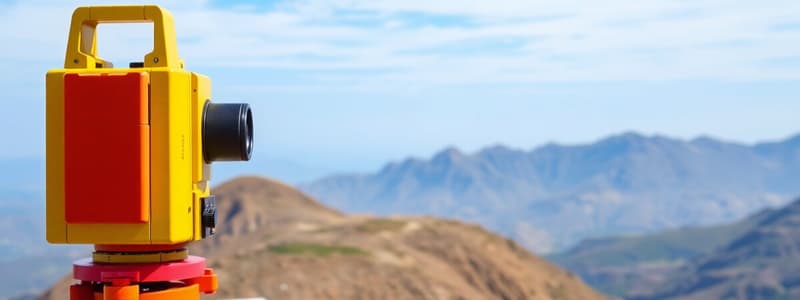Podcast
Questions and Answers
Which type of surveying is appropriate for small areas where the curvature of the Earth is negligible?
Which type of surveying is appropriate for small areas where the curvature of the Earth is negligible?
- Hydrographic Surveying
- Geodetic Surveying
- Plane Surveying (correct)
- Topographic Surveying
What is the primary objective of surveying?
What is the primary objective of surveying?
- To measure the curvature of the Earth.
- To determine the exact height of mountains.
- To predict future rainfall patterns.
- To create accurate plans and maps. (correct)
What does a plumb line represent in plane surveying?
What does a plumb line represent in plane surveying?
- A line that converges towards the Earth's center.
- A line that is independent of the Earth's curvature. (correct)
- A line parallel to the Earth's surface.
- A line perpendicular to the Earth's surface.
Which surveying method is characterized by defining the overall area first and then breaking it down into smaller parts?
Which surveying method is characterized by defining the overall area first and then breaking it down into smaller parts?
Which of the following is NOT a principle of surveying?
Which of the following is NOT a principle of surveying?
What is the purpose of conducting a hydrographic survey?
What is the purpose of conducting a hydrographic survey?
Which type of surveying is essential for defining property boundaries and creating legal maps?
Which type of surveying is essential for defining property boundaries and creating legal maps?
Which surveying method involves connecting points by lines and measuring their lengths and bearings?
Which surveying method involves connecting points by lines and measuring their lengths and bearings?
What is the significance of independent measurements in surveying?
What is the significance of independent measurements in surveying?
Which of these options could be considered independent measurements?
Which of these options could be considered independent measurements?
What is the primary difference between a plan and a map in surveying?
What is the primary difference between a plan and a map in surveying?
Which surveying method uses a leveling instrument to determine the elevation of points?
Which surveying method uses a leveling instrument to determine the elevation of points?
What is the purpose of the planning stage in surveying?
What is the purpose of the planning stage in surveying?
Which type of surveying is used for mapping the infrastructure and features of a city?
Which type of surveying is used for mapping the infrastructure and features of a city?
Which type of surveying is used for determining the position of celestial bodies?
Which type of surveying is used for determining the position of celestial bodies?
Which type of surveying is used for investigating archaeological sites?
Which type of surveying is used for investigating archaeological sites?
What is surveying primarily concerned with?
What is surveying primarily concerned with?
What type of measurement describes the distance between two points lying on the same plane?
What type of measurement describes the distance between two points lying on the same plane?
Why is surveying critical in civil engineering?
Why is surveying critical in civil engineering?
Which of the following is NOT a primary focus area of the surveying course?
Which of the following is NOT a primary focus area of the surveying course?
Which chapter is likely to cover the principles for establishing site boundaries?
Which chapter is likely to cover the principles for establishing site boundaries?
What do angular measurements in surveying typically quantify?
What do angular measurements in surveying typically quantify?
Which of the following techniques is mentioned as part of the course structure?
Which of the following techniques is mentioned as part of the course structure?
What is emphasized as a key to success in the surveying course?
What is emphasized as a key to success in the surveying course?
Flashcards
What is Surveying?
What is Surveying?
The art of determining the relative position of points on the earth's surface using linear and angular measurements.
Relative Position
Relative Position
A point's position is defined in relation to another point.
Linear Measurements
Linear Measurements
Measurements of distances, both horizontally and vertically.
Horizontal Distance
Horizontal Distance
Signup and view all the flashcards
Vertical Distance
Vertical Distance
Signup and view all the flashcards
Angular Measurements
Angular Measurements
Signup and view all the flashcards
Surveying Importance in Civil Engineering
Surveying Importance in Civil Engineering
Signup and view all the flashcards
Course Overview
Course Overview
Signup and view all the flashcards
Horizontal Angle
Horizontal Angle
Signup and view all the flashcards
Vertical Angle
Vertical Angle
Signup and view all the flashcards
Plane Survey
Plane Survey
Signup and view all the flashcards
Geodetic Survey
Geodetic Survey
Signup and view all the flashcards
Land Surveying
Land Surveying
Signup and view all the flashcards
Hydrographic Surveying
Hydrographic Surveying
Signup and view all the flashcards
Chain Surveying
Chain Surveying
Signup and view all the flashcards
Compass Surveying
Compass Surveying
Signup and view all the flashcards
Plane Table Surveying
Plane Table Surveying
Signup and view all the flashcards
Level Surveying
Level Surveying
Signup and view all the flashcards
Cadastral Surveying
Cadastral Surveying
Signup and view all the flashcards
Archaeological Surveying
Archaeological Surveying
Signup and view all the flashcards
Working from Whole to Part
Working from Whole to Part
Signup and view all the flashcards
Working from Part to Whole
Working from Part to Whole
Signup and view all the flashcards
Plumb Line
Plumb Line
Signup and view all the flashcards
Study Notes
Crash Course: Surveying
- This course helps students learn surveying quickly and efficiently, focusing on the GATE exam.
- It is beneficial for beginners and experienced learners, covering all key topics and emphasizing revision.
What is Surveying?
- Surveying is determining the relative positions of points on (or above/below) the Earth's surface.
- It uses linear and angular measurements to define these positions.
Key Terms:
- Relative Position: A point's location is referenced to another point.
- Linear Measurements: Distances (horizontal and vertical).
- Horizontal Distance: Distance between points on the same plane.
- Vertical Distance: Distance between points on different planes.
- Angular Measurements: Angles between lines or planes.
Surveying Importance in Civil Engineering
- Civil engineering projects (roads, buildings, etc.) rely on surveying.
- Surveying gathers site data for effective project planning, including:
- Land size and shape
- Feature locations and elevations
- Construction layout
Course Overview
- This course covers fundamental surveying topics for the GATE exam.
- It focuses on understanding concepts and application, including:
- Definitions and classifications of surveying
- Principles and objectives of surveying
- Divisions of surveying
- Surveying operations
- Basic surveying tools and techniques
- Linear measurements
- Angular measurements
- Surveying applications in civil engineering
Course Structure
- Chapters include:
- Fundamentals of Surveying
- Linear Measurements
- Compass Surveying
- Traverse Surveying
- Levelling and Contouring
- Plane Table Surveying
- Survey Computations (area and volume)
- Basics of GPS and Remote Sensing
- Classes are Monday-Friday, 6:32 PM-8:30 PM.
- Entire course completed by December 31st.
Tips for Success
- Attend all classes.
- Review notes thoroughly.
- Practice with GATE exam questions and other resources.
- Consider enrolling in a test series.
Angular Measurement
- Angular measurement is determining angles.
- Types: horizontal and vertical.
- Horizontal angles are between lines on the same plane.
- Vertical angles are between lines on different planes.
Types of Surveying
- Plane Survey: Neglects Earth's curvature; suitable for small areas (up to 12 km). Difference between curved and horizontal lengths is minimal (8-10 meters).
- Geodetic Survey: Considers Earth's curvature; used for larger areas where curvature is significant.
Classification of Surveying
- Based on Place of Survey:
- Land Surveying: Land boundaries, features, and elevations.
- Hydrographic Surveying: Water bodies (depths, currents, obstacles).
- Marine Surveying: Coastal and offshore areas (similar to hydrographic).
- Based on Instruments:
- Chain Surveying: Measuring distances with chain/tape.
- Tape Surveying: More accurate distance measurements.
- Compass Surveying: Bearings and angles with a compass.
- Plane Table Surveying: Plotting features directly with a plane table and alidade.
- Level Surveying: Determining elevations with a level instrument.
- Based on Purpose/Objective:
- Topographic Surveying: Elevations and positions of features.
- City Surveying: City infrastructure mapping (roads, water, sewage).
- Route Surveying: Road/rail/pipeline routes.
- Cadastral Surveying: Property boundaries, legal maps.
- Archaeological Surveying: Archaeological site investigation.
- Geological Surveying: Geological features, minerals, and rocks.
- Astronomical Surveying: Celestial body positions.
- Based on Method:
- Traversing: Connecting points with measured lines/bearings.
- Triangulation: Establishing triangles for distance calculations.
- Trigonometrical Surveying: Extensive trigonometry for distance/elevation calculations.
Principles of Surveying
- Whole to Part: Precisely define the entire area initially (control points), then survey details. Improves error control/cross-checking.
- Part to Whole: Surveying smaller sections first; less accurate with potential error accumulation.
- Recommended approach: "Whole to Part" for accuracy.
Plumb Line and Direction of Gravity
- A plumb line (gravity line) points towards Earth's center.
- Plane surveying: Considers plumb lines parallel.
- Geodetic surveying: Plumb lines converge at Earth's center.
Principles of Surveying (continued)
- Second Principle: Independent measurements.
- Independent Measurements: Separate measurements not reliant on each other.
- Examples: Two linear, two angular, or one linear-one angular.
- Importance: If one has an error, it does not influence independent ones.
Objective of Surveying
- Main aim: Accurate plans and maps (features/characteristics).
- Plan: Future design for a construction.
- Map: Graphical representation of a geographic area.
- Example: Campus map details using accurate measurements.
- Process: Defining ground points; transferring them to a drawing.
- Result: Detailed plan or map using collected data.
Operations in Surveying
- To create a Plan or Map:
- Planning: Determine surveying tools, methods, resources, accuracy.
- Field Measurements: Collect data (linear/angular) using instruments.
- Data Processing and Plotting: Convert data into maps/plans by calculations/plotting.
Studying That Suits You
Use AI to generate personalized quizzes and flashcards to suit your learning preferences.




